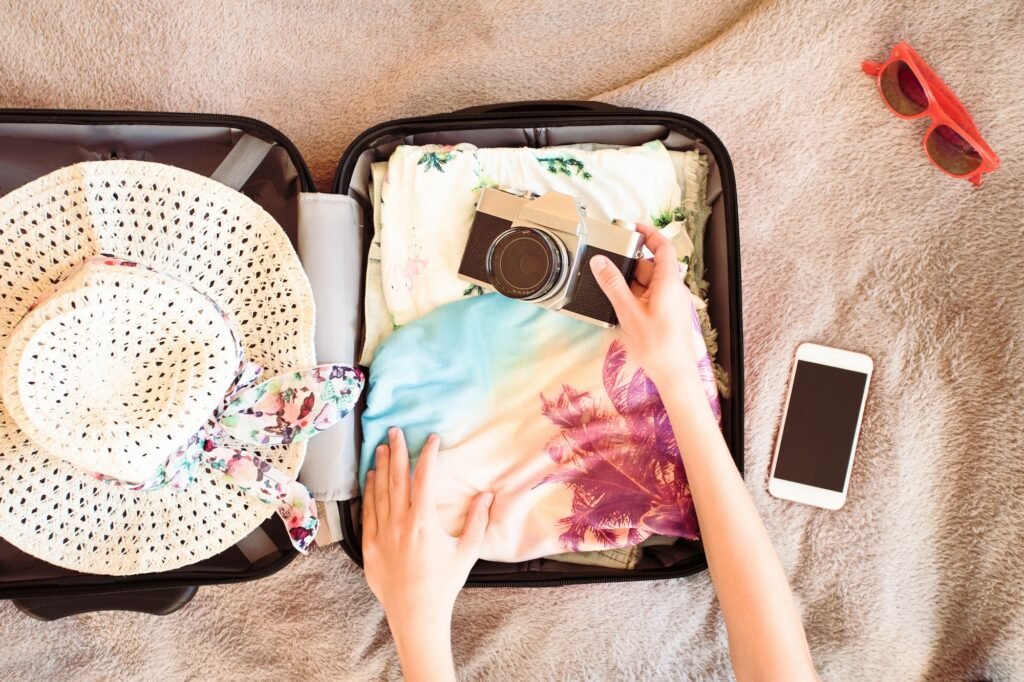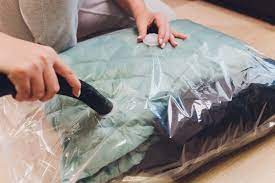Want to save space in your closet or luggage? Vacuum-sealing clothes might just be the solution you need.
By using a vacuum sealer and vacuum seal bags, you can compress your clothing and remove air from the bag, creating a vacuum pressure that shrinks the size of your clothes.
But it’s not just about saving space.
Vacuum-sealing clothes can also protect them from moisture and bugs, making it a great option for long-term storage. And if you’re into sous vide cooking, vacuum-sealed bags can also be used for cooking jackets and other clothing items.
So how do you use a vacuum sealer on clothes? How do you use vacuum sealer bags for clothes? Can you vacuum seal clothes at home without a machine or a regular vacuum cleaner?
And most importantly, how does this process actually work?
In this article, we’ll answer all these questions and more as we explore the ins and outs of vacuum-sealing clothes. From compression seals to zip seals, we’ll cover everything you need to know to get started with this handy storage technique.
How Vacuum Sealing Benefits Clothes Storage and Travel

Vacuum-sealing clothes is a game-changer for those who want to maximize their storage space or travel light without having to sacrifice outfits. With the help of space saver vacuum seal storage bags, you can store more clothes in a smaller space, keep your closet organized, and optimize bed storage.
Space Saver Vacuum Seal Storage Bags
Space saver vacuum seal storage bags are perfect for maximizing clothes storage space. By removing the air from the bag, you can compress your clothes into a compact size that takes up less room in your closet or luggage. Plus, these bags protect your clothes from moisture, dust, and insects.
Closet and Bed Storage
Vacuum sealing is a great way to keep clothes organized in closet storage areas. You can sort them by category or season and easily find what you need without rummaging through piles of garments. Bed storage can also be optimized with space saver vacuum seal storage bags. You can store extra blankets, bedding sets, or pillows without taking up too much space.
Long Term Clothes Storage
Long-term clothes storage is made easy with vacuum sealing. If you have seasonal items that you won’t be using for months, such as winter coats or summer dresses, vacuum sealing them will prevent them from getting damaged by humidity or pests.
Travel Hand Luggage
Travel hand luggage can be maximized with vacuum-sealed clothes. Instead of carrying bulky suitcases that may exceed weight limits on flights, pack your essentials in small vacuum-sealed bags that fit perfectly into your carry-on bag.
Addressing Concerns About Vacuum Seal Storage Bag Damage
Vacuum seal storage bags have become a popular choice for storing clothes and other items due to their space-saving abilities. However, some people are concerned about the potential damage that can be caused by vacuum sealing. Here are some points to address those concerns:
The Durability of Vacuum Seal Bags
Vacuum seal bags are made of durable materials such as polyethylene and nylon, which can withstand compression without tearing or puncturing. This means that your clothes will remain safe and protected inside the bag, even when compressed.
Double Zip Seal
The double zip seal on vacuum seal bags ensures a tight seal that prevents air from entering the bag and causing damage to the contents. The seal is also easy to use – simply slide your fingers along the zipper to close it securely.
Reusability of Compression Bags
Compression bags are designed to be used repeatedly, making them a cost-effective and eco-friendly storage solution for clothing and other items. You can reuse them multiple times before needing to replace them.
It’s important to note that not all items can be vacuum sealed. Items like photographs, important documents, or delicate fabrics should not be stored in vacuum-sealed bags as they may become damaged.
Best Types of Vacuum Storage Bags for Clothes
Vacuum storage bags are a great solution for storing clothes that take up too much space in your closet or luggage. However, not all vacuum storage bags are created equal. Here are the best types of vacuum storage bags for clothes:
Space Saver Vacuum Storage Bags for Bulky Clothes
Space-saver vacuum storage bags are perfect for bulky clothes like winter jackets and comforters. These bags can compress your items by up to 80%, making them easy to store in small spaces.
Gongshi Bags for Maximum Compression
If you’re looking for maximum compression, try Gongshi bags. They can compress your clothes by up to 90% and come with a double-zip seal to ensure an airtight closure.
Jumbo Bags for Larger Items
Jumbo vacuum storage bags are ideal for larger items like duvets and blankets. They have extra-large capacities, so you can store more items in one bag.
Trash Bags Are Not Recommended as Vacuum Storage Bags
While it may be tempting to use a trash bag as a cheaper alternative to vacuum storage bags, it’s not recommended. Trash bags are not designed to withstand the pressure of being vacuum sealed and may break open, leaving your clothes unprotected.
Preparing Clothes for Vacuum Sealing: Air Out and Iron
Before vacuum sealing your clothes, it’s important to prepare them properly to ensure an airtight seal. Here are some tips to follow:
Air out clothes before vacuum sealing
Air out your clothes for a few hours before vacuum sealing them. This will help remove any moisture and odors that may be trapped in the fabric. Hang your clothes outside or near an open window to allow fresh air to circulate through them.
Iron clothes to remove wrinkles
Ironing your clothes is another crucial step in preparing them for vacuum sealing. This will help remove any wrinkles and ensure that they lay flat, which is necessary for an airtight seal. Be sure to adjust the heat setting on your iron based on the material of your clothing. Wool and silk may require lower heat settings, while cotton can handle higher heat.
Use an electric air pump or hand pump
To create the necessary pressure for vacuum sealing, you’ll need either an electric air pump or a hand pump. Electric pumps are more efficient but can be expensive, while hand pumps are more affordable but require more effort.
Consider the material of the clothes
Different materials require different care. For example, delicate fabrics like silk should be handled with care and may require lower heat settings when ironing.
By following these tips, you can ensure that your clothes are properly prepared for vacuum sealing. This will not only save space in your closet but also protect your clothing from dust, moisture, and pests like moths.
Checking Clothes for Damage Before and After Vacuum Sealing
Before vacuum sealing your clothes, it is essential to check them for any damage. You don’t want to seal damaged clothes as this can cause further harm. Ensure that there are no holes, tears, or stains on the clothes.
It’s also crucial to test different sizes of bags before sealing to avoid errors. Place a few items in each bag and try out different sizes until you find the perfect fit. This will help ensure that your clothes are properly sealed without any excess air.
Another important thing to do before vacuum sealing is to count the number of clothes you plan to seal to ensure you have enough space. This will prevent overcrowding and damage during the sealing process.
After the testing period, it’s time to check your clothes again for any damage. Inspect them carefully and make sure everything looks good before storing them away.
Preventing Moth and Moisture Damage in Vacuum Sealed Clothes
Moths and moisture can wreak havoc on your clothes, causing damage that’s difficult to repair. Fortunately, vacuum sealing clothes is an effective way to prevent both types of damage.
Vacuum Sealing Prevents Moth Damage
Moths are attracted to food sources, including natural fibers in clothing. When moths lay their eggs on clothing, the larvae feed on the fibers and create holes. This damage can be prevented by vacuum sealing your clothes.
Vacuum sealing removes all the air from the bag, which means there’s no oxygen for moths to breathe. Without oxygen, moth eggs can’t hatch and larvae can’t survive. This makes vacuum-sealed bags an excellent choice for storing woolen and other natural fiber garments.
Vacuum Sealing Prevents Moisture Damage
Moisture can cause mold and mildew growth on clothing, leading to unsightly stains and unpleasant odors. Vacuum-sealing clothes prevent moisture from getting into the bag in the first place.
When you vacuum seal clothing items, you remove all of the air from the bag. This includes any moisture that might be present in the air. Once sealed, there’s no way for more moisture to get inside unless you open up the bag again.
The Advantages of Vacuum Sealing Clothes
In conclusion, vacuum-sealing clothes is an excellent way to store and travel with your garments. By removing excess air, you can save space in your closet or luggage while also protecting your clothes from moisture and pests. When choosing a vacuum storage bag, make sure to select a durable option that won’t easily tear or puncture.
Before vacuum sealing, it’s important to air out and iron your clothes to prevent any wrinkles or odors from becoming permanent. You should inspect your clothes for any damage before and after sealing them in the bag.
To ensure that your vacuum-sealed clothes remain in good condition over time, store them in a cool, dry place away from direct sunlight. You may also want to consider using mothballs or other anti-moth products to prevent damage from pests.
Overall, vacuum sealing is a simple yet effective method for preserving the quality of your clothes. Whether you’re storing seasonal items or packing for a trip, this technique can help you maximize space while keeping your wardrobe safe and organized. So why not give it a try? Your future self (and closet) will thank you!

